Solved Problem on Coulomb's Law
advertisement
Two identical spheres, A and B, are fixed on a flat, horizontal glass sheet at a distance d from each other. Sphere A is initially neutral, and B is charged. A third sphere C, identical to the first two and initially neutral, is placed in contact with B and then with A. Determine at what distance x from sphere A, on the straight line AB, should sphere C be placed so that it remains in equilibrium.
Problem data:
- Charge of sphere A: QA = 0;
- Charge of sphere B: QB = Q;
- Charge of sphere C: QC = 0;
- Distance between spheres A and B: d.
We use Q for the initial charge of sphere B, and a reference frame with an origin in
A and oriented to B. Sphere B is at a distance d from sphere A
(Figure 1). First, we calculate the charge that the other spheres will acquire by contact.
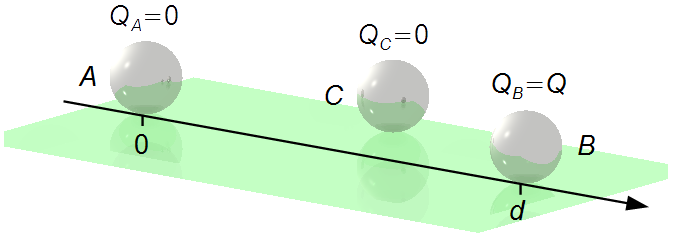
We put spheres B and C in contact, the charge of B will be distributed equally
over the two spheres (Figure 2)
\[
\begin{gather}
Q_{B}=Q_{C}=\frac{Q_{B}+Q_{C}}{2}=\frac{Q+0}{2}=\frac{Q}{2}
\end{gather}
\]
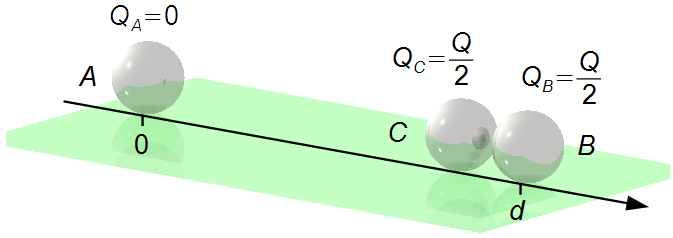
Now sphere C, with a charge equal to
\( \frac{Q}{2} \),
is placed in contact with sphere A with a charge equal to zero, and the charge of
C will be distributed over both spheres (Figure 3).
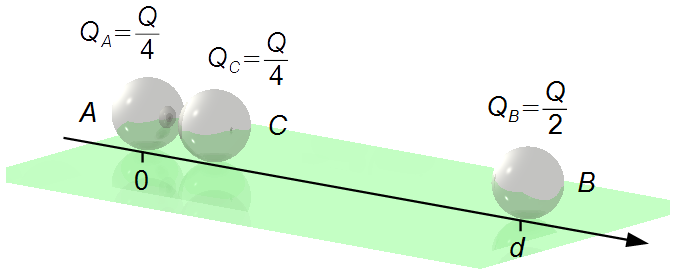
\[
\begin{gather}
Q_{A}=Q_{C}=\frac{Q_{A}+Q_{C}}{2}=\frac{0+\dfrac{Q}{2}}{2}=\frac{Q}{2}\times\frac{1}{2}=\frac{Q}{4}
\end{gather}
\]
In the final situation, spheres A and C have charges
\( Q_{A}=Q_{C}=\frac{Q}{4} \),
and sphere B has charge
\( Q_{B}=\frac{Q}{2} \).
Sphere C should be placed at a point x between A and B to remain in
equilibrium (Figure 4).
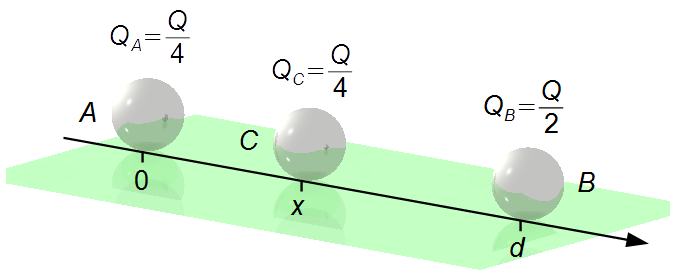
For it to be in equilibrium, the force acting between spheres A and C must be equal to
the force acting between B and C, so that the resultant of the forces is equal to zero
(Figure 5)
\[
\begin{gather}
{\vec{F}}_{AC}={\vec{F}}_{BC} \tag{I}
\end{gather}
\]
According to Coulomb's Law, the electric force is given, in magnitude, by
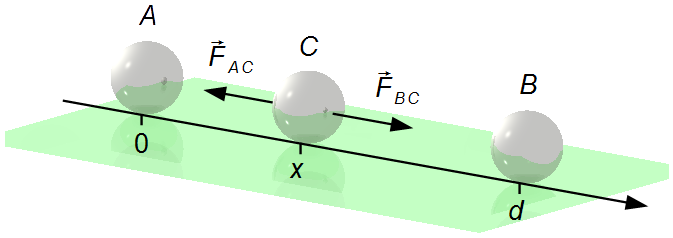
\[
\begin{gather}
\bbox[#99CCFF,10px]
{F_{E}=k_{0}\frac{|Q_{1}||Q_{2}|}{r^{2}}} \tag{II}
\end{gather}
\]
Applying expression (II) to spheres A and C
\[
\begin{gather}
F_{AC}=k_{0}\frac{Q_{A}Q_{C}}{x^{2}}\\[5pt]
F_{AC}=k_{0}\frac{\dfrac{Q}{4}\dfrac{Q}{4}}{x^{2}}\\[5pt]
F_{AC}=k_{0}\frac{Q^{2}}{16x^{2}} \tag{III}
\end{gather}
\]
For spheres B and C, the distance between them will be r = (d − x),
substituting the data in (II) for this situation
\[
\begin{gather}
F_{BC}=k_{0}\frac{Q_{B}Q_{C}}{(d-x)^{2}}\\[5pt]
F_{BC}=k_{0}\frac{\dfrac{Q}{2}\dfrac{Q}{4}}{(d-x)^{2}}\\[5pt]
F_{BC}=k_{0}\frac{Q^{2}}{8(d-x)^{2}} \tag{IV}
\end{gather}
\]
Applying condition (I) to expressions (III) and (IV)
\[
\begin{gather}
\cancel{k_{0}}\frac{\cancel{Q^{2}}}{\cancelto{2}{16}x^{2}}=\cancel{k_{0}}\frac{\cancel{Q^{2}}}{\cancel{8}(d-x)^{2}}\\[5pt]
\frac{1}{2x^{2}}=\frac{1}{(d-x)^{2}}\\[5pt]
(d-x)^{2}=2x^{2}\\[5pt]
d^{2}-2dx+x^{2}=2x^{2}\\[5pt]
2x^{2}-x^{2}+2dx-d^{2}=0\\[5pt]
x^{2}+2dx-d^{2}=0
\end{gather}
\]
This is a Quadratic Equation in x.
Solution of the Quadratic Equation
\( x^{2}+2dx-d^{2}=0 \)
\[
\begin{gather}
\Delta =b^{2}-4ac=\left(2d\right)^{2}-4\times 1\times (-d^{2})=4d^{2}+4d^{2}=8d^{2}\\[10pt]
x=\frac{-b\pm\sqrt{\Delta }}{2a}=\frac{-2d\pm \sqrt{8d^{2}}}{2\times 1}=\frac{-2d\pm2d\sqrt{2\;}}{2}
\end{gather}
\]
the two roots of the equation will be
\[
\begin{gather}
x_{1}=d(\sqrt{2\;}-1)\\
\qquad \mathrm{e}\\
x_{2}=-d(\sqrt{2\;}-1)
\end{gather}
\]
The distance d is greater than zero, and the term in parentheses, \( (\sqrt{2 \;}-1)\approx 0.4142 \), is greater than zero. So the first root is worth approximately 0.41d, therefore it is between spheres A and B as the statement asks; the second root has a negative sign, so it is to the left of sphere A, on the negative side of the reference frame (Figure 1) and can be neglected.
\[
\begin{gather}
\bbox[#FFCCCC,10px]
{x_{1}=d(\sqrt{2 \;}-1)}
\end{gather}
\]
advertisement

Fisicaexe - Physics Solved Problems by Elcio Brandani Mondadori is licensed under a Creative Commons Attribution-NonCommercial-ShareAlike 4.0 International License .